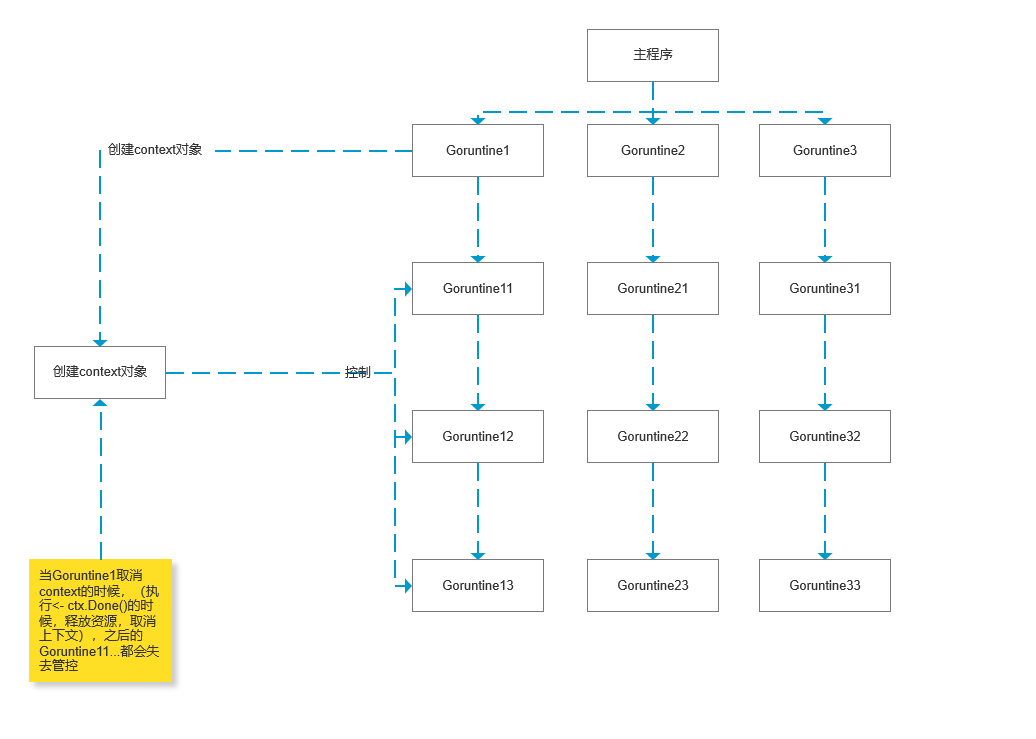学習状況
- 設計の構造体のコンテキスト
type Context interface {
Deadline() (deadline time.Time, ok bool)
Done() <-chan struct{}
Err() error
Value(key interface{}) interface{}
}- 分析で構造体フィールド
- 期限()期限の設定を戻し、設定された期限か
- ()完了を返す読み取り専用のリソースを解放するかどうかを通知するために使用ちゃん、
- errが()キャンセルの理由を返します。
- 値(キーインターフェイス{})キーと値のペアの文脈で結合値を取得します。この値は、スレッドセーフです。(正確に共有変数を扱うことができる同時の場合には)
- コンテキストの一般的な方法の例
- 参照コード
package main
import(
"fmt"
"time"
"golang.org/x/net/context"
)
type faveContextKey string //定义别名
func main(){
fmt.Println("context包学习")
UseContext()
UseContextWithDeadline()
UseContextWithTimeout()
UseContextWithValue()
}
func UseContext(){
// 使用withCancel生成上下文
gen := func (ctx context.Context)<- chan int{
dst := make(chan int) //无缓冲,无长度
n := 1
fmt.Println("这个函数被调用多少次:",n) //被调用一次
go func (){
for{
select{
// 多个case同时满足,就会随机执行case
case <- ctx.Done():
// 关闭上下文
fmt.Println("ctx.Done",ctx.Err(),n)
return
case dst <- n: //要么运行完这个作用域,要么就不用运行
n++
fmt.Printf("n = %v \n",n)
}
}
}()
//发送器
return dst
}
ctx,cancel := context.WithCancel(context.Background())
defer cancel()
data := gen(ctx)
for n:= range data{ //接收
fmt.Println(n)
if n== 16{
break
}
}
}
func UseContextWithDeadline(){
// withDeadline作用:设置context的存活期
d := time.Now().Add(50 * time.Millisecond)
ctx,cancel := context.WithDeadline(context.Background(),d)
if ctx == nil{
fmt.Println("ctx is nil")
return
}
defer cancel()
select{
case <-time.After(time.Second*1):
fmt.Println("overslept")
case <- ctx.Done():
fmt.Println(ctx.Err())
}
}
func UseContextWithTimeout(){
// withTimeout作用:设置context的存活期
ctx,cancel := context.WithTimeout(context.Background(),50*time.Millisecond)
if ctx == nil{
fmt.Println("ctx is nil")
return
}
defer cancel()
select{
case <-time.After(time.Second*1):
fmt.Println("overslept")
case <- ctx.Done():
fmt.Println(ctx.Err())
}
}
func UseContextWithValue(){
// withValue作用:带值
f := func(ctx context.Context,k faveContextKey){
if v := ctx.Value(k);v!=nil{
fmt.Printf("key:%v,value:%v \n",k,v)
}else{
fmt.Println("key not found!",k)
}
}
k := faveContextKey("language")
ctx:= context.WithValue(context.Background(),k,"go")
if ctx==nil{
fmt.Println("ctx is nil")
}
f(ctx,k)
f(ctx,faveContextKey("color"))
}パケットコンテキストを使用します
- 制御層Goruntine層Goruntineの下に実現関係の建物のコンテキストツリー、。次の層の制御のためGoruntineコンテキストは、オブジェクト変数を介して渡されます。通知制御信号完了コンテキストオブジェクト()。
- 参考用例

ブログを理解しやすくするために、(侵害は、私は削除させていただきます、ご連絡ください)
- 私は議論する悪い場所、プラスマイクロチャンネルを書くことができます。ありがとう
